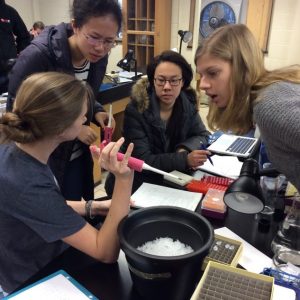About CUREs
![]()
At Carolina, we can offer our undergraduates cutting-edge, one-on-one research apprenticeships with professors. Yet there are not enough of these one-on-one opportunities for all of our students. Course-based Undergraduate Research Experiences (CURE) can solve this problem and bring a professor’s research expertise to a classroom.
By bringing research professors and their own research into classrooms, our institution is betting that we’ll see the kinds of learning outcomes gained in research apprenticeships—for more students, earlier in their undergraduate careers.
We are developing a diverse array of CURE classes across the College curriculum, in numerous disciplines. See our course listings. Of note, we’re revamping our introductory biology and chemistry labs to impact large numbers of students across these multi-section courses, see how.
A typical CURE design is one in which students learn technical skills that they use to answer novel research questions. Neither the student nor the professor know the answer to the questions. This is real research, not students following a “recipe” written in a lab manual as done by thousands of students before them or writing the same analysis paper in a humanities class that others have written before. Besides answering novel questions, a CURE has four other characteristics: (1) there are chances for students to fail and try again; (2) students take ownership of their project; (3) there is meaningful collaboration with peers; and (4) the students communicate their findings outside the classroom.
“I was in charge of my own developing research rather than proving ideas that already existed…everyone reached out to help others and share ideas with combined knowledge. I felt like I was contributing and what I had to bring was worth something.”
 Students can simply enroll in a CURE course-no networking required. Because there are few to no prerequisites for many CUREs, there are likely to be many first- and second-year students in the class. Enrollment is typically about 20-30 students in a section; so many more students have opportunities to participate in research with a professor through CUREs than through a traditional research lab setting. The research is part of their coursework, this may be better-structured learning experience than an apprenticeship for some students. There will be a syllabus, assignments, feedback, and opportunities to work with and learn from peers.
Students can simply enroll in a CURE course-no networking required. Because there are few to no prerequisites for many CUREs, there are likely to be many first- and second-year students in the class. Enrollment is typically about 20-30 students in a section; so many more students have opportunities to participate in research with a professor through CUREs than through a traditional research lab setting. The research is part of their coursework, this may be better-structured learning experience than an apprenticeship for some students. There will be a syllabus, assignments, feedback, and opportunities to work with and learn from peers.
Faculty are likely to be more passionate about teaching a CURE course than a more traditional course. They share in the excitement when students have their first taste of discovery; they experience the rewards of teaching students to do research. Sometimes the results are fruitful enough to publish or jump-start a new project in their own lab. Thus, there can be efficiencies when the class research aligns with one’s own research interests. As faculty do hands-on research with students, they learn who the “top” students are based on creativity, curiosity, and self-efficacy rather than GPA. The process creates a skilled and diverse pipeline of researchers who might continue with the faculty one-on-one or who might be recommended for other high-impact opportunities.
WHAT ARE THE ESSENTIAL CHARACTERISTICS OF A CURE?
Discovery/Novel
The investigation’s outcome/answer is unknown to both the students and the instructor. Students must make decisions such as how to interpret their data, when to track down an anomaly and when to ignore it as “noise” or when results are sufficiently convincing to draw conclusions. Students’ findings offer some new insight into how the world works.
Broadly Relevant
CUREs provide opportunities for students to build on and contribute to current knowledge; they also present opportunities for impact and action beyond the classroom. In some CUREs, this may manifest as authorship or acknowledgement in a research publication or students may develop reports/recommendations of interest to the local community.
Use of Evidence-based Practices
Asking questions, building and evaluating models, proposing hypotheses, designing studies, selecting methods, using technical tools of inquiry/investigation, gathering and analyzing data, identifying meaningful variation, navigating the messiness of real-world data, developing and critiquing interpretations and arguments, and communicating findings.
Collaboration
Through collaboration, students can improve their work in response to peer feedback. Collaboration also develops important intellectual and communication skills as students verbalize their thinking and practice communicating ideas and interpretation either to fellow students in the same discipline or to students in other disciplines.
Iteration
Students learn by trying, failing, and trying again, and by critiquing one another’s work, especially the extent to which claims can be supported by evidence. Students may design, conduct, and interpret an investigation and, based on their results, repeat or revise aspects of their work to address problems or inconsistencies, rule out alternative explanations, or gather additional data to support assertions. Students may also build on or revise aspects of other students’ investigations, whether within a single course to accumulate a sufficiently large data set for analysis or across successive offerings of the course to measure and manage variation, further test preliminary hypotheses, or increase confidence in previous findings.
STRUCTURE ↔ PROJECT OWNERSHIP
Adapted from: CBE Life Sci Educ. 2014 Spring;13(1):29-40
WANT MORE?
Read a UNC Endeavors article Reverine Re[Sr]ch: An Undergraduate’s Journey in Geology.
A message from our QEP Director about our CURE program and opportunity for all students.
Check out this video detailing the Seafood Forensics class (BIOL 221L).
Read an Arts & Science magazine article about some of our first CUREs.
